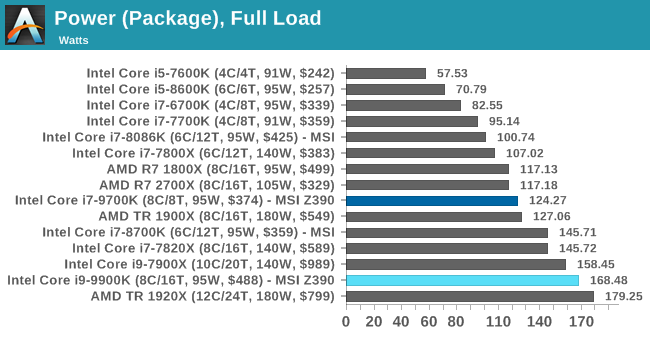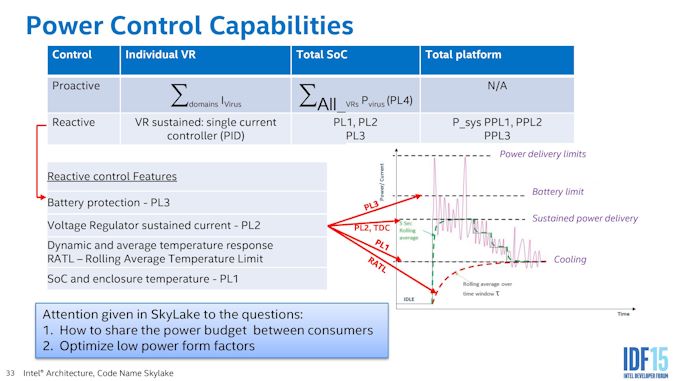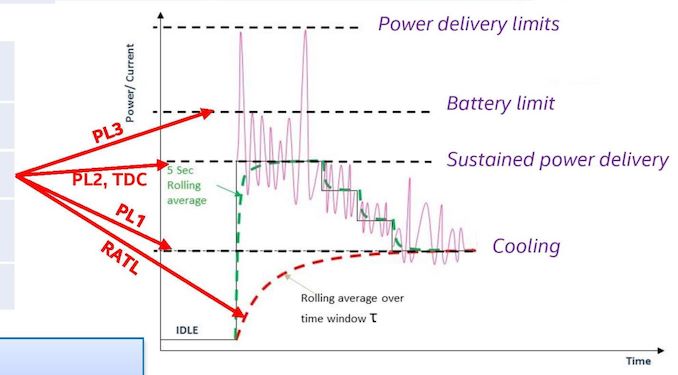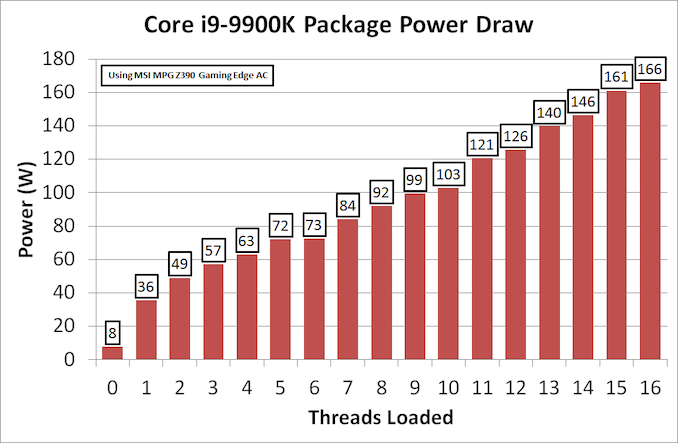The Intel 9th Gen Review: Core i9-9900K, Core i7-9700K and Core i5-9600K Tested
by Ian Cutress on October 19, 2018 9:00 AM EST- Posted in
- CPUs
- Intel
- Coffee Lake
- 14++
- Core 9th Gen
- Core-S
- i9-9900K
- i7-9700K
- i5-9600K
Power Consumption
TDP or not the TDP, That is The Question
Notice: When we initially posted this page, we ran numbers with an ASRock Z370 board. We have since discovered that the voltage applied by the board was super high, beyond normal expectations. We have since re-run the numbers using the MSI MPG Z390 Gaming Edge AC motherboard, which does not have this issue.
As shown above, Intel has given each of these processors a Thermal Design Power of 95 Watts. This magic value, as mainstream processors have grown in the last two years, has been at the center of a number of irate users.
By Intel’s own definitions, the TDP is an indicator of the cooling performance required for a processor to maintain its base frequency. In this case, if a user can only cool 95W, they can expect to realistically get only 3.6 GHz on a shiny new Core i9-9900K. That magic TDP value does not take into account any turbo values, even if the all-core turbo (such as 4.7 GHz in this case) is way above that 95W rating.
In order to make sense of this, Intel uses a series of variables called Power Levels: PL1, PL2, and PL3.
That slide is a bit dense, so we should focus on the graph on the right. This is a graph of power against time.
Here we have four horizontal lines from bottom to top: cooling limit (PL1), sustained power delivery (PL2), battery limit (PL3), and power delivery limit.
The bottom line, the cooling limit, is effectively the TDP value. Here the power (and frequency) is limited by the cooling at hand. It is the lowest sustainable frequency for the cooling, so for the most part TDP = PL1. This is our ‘95W’ value.
The PL2 value, or sustained power delivery, is what amounts to the turbo. This is the maximum sustainable power that the processor can take until we start to hit thermal issues. When a chip goes into a turbo mode, sometimes briefly, this is the part that is relied upon. The value of PL2 can be set by the system manufacturer, however Intel has its own recommended PL2 values.
In this case, for the new 9th Generation Core processors, Intel has set the PL2 value to 210W. This is essentially the power required to hit the peak turbo on all cores, such as 4.7 GHz on the eight-core Core i9-9900K. So users can completely forget the 95W TDP when it comes to cooling. If a user wants those peak frequencies, it’s time to invest in something capable and serious.
Luckily, we can confirm all this in our power testing.
For our testing, we use POV-Ray as our load generator then take the register values for CPU power. This software method, for most platforms, includes the power split between the cores, the DRAM, and the package power. Most users cite this method as not being fully accurate, however compared to system testing it provides a good number without losses, and it forms the basis of the power values used inside the processor for its various functions.
Starting with the easy one, maximum CPU power draw.

Focusing on the new Intel CPUs we have tested, both of them go beyond the TDP value, but do not hit PL2. At this level, the CPU is running all cores and threads at the all-core turbo frequency. Both 168.48W for the i9-9900K and 124.27W for the i7=9700K is far and above that ‘TDP’ rating noted above.
Should users be interested, in our testing at 4C/4T and 3.0 GHz, the Core i9-9900K only hit 23W power. Doubling the cores and adding another 50%+ to the frequency causes an almost 7x increase in power consumption. When Intel starts pushing those frequencies, it needs a lot of juice.
If we break out the 9900K into how much power is consumed as we load up the threads, the results look very linear.
This is as we load two threads onto one core at a time. The processor slowly adds power to the cores when threads are assigned.
Comparing to the other two ‘95W’ processors, we can see that the Core i9-9900K pushes more power as more cores are loaded. Despite Intel officially giving all three the same TDP at 95W, and the same PL2 at 210W, there are clear differences due to the fixed turbo tables embedded in each BIOS.
So is TDP Pointless? Yes, But There is a Solution
If you believe that TDP is the peak power draw of the processor under default scenarios, then yes, TDP is pointless, and technically it has been for generations. However under the miasma of a decade of quad core processors, most parts didn’t even reach the TDP rating even under full load – it wasn’t until we started getting higher core count parts, at the same or higher frequency, where it started becoming an issue.
But fear not, there is a solution. Or at least I want to offer one to both Intel and AMD, to see if they will take me up on the offer. The solution here is to offer two TDP ratings: a TDP and a TDP-Peak. In Intel lingo, this is PL1 and PL2, but basically the TDP-Peak takes into account the ‘all-core’ turbo. It doesn’t have to be covered under warranty (because as of right now, turbo is not), but it should be an indication for the nature of the cooling that a user needs to purchase if they want the best performance. Otherwise it’s a case of fumbling in the dark.














274 Comments
View All Comments
BloodyBunnySlippers - Friday, October 19, 2018 - link
The big take away for me: As resolution rises above 1080P, the performance differences narrows to almost nothing. And there is the Ryzen 5 2600x beating the 2700x (in gaming). I can get that at Micro Center for $190. That looks like a great performance/price ratio there.Achaios - Friday, October 19, 2018 - link
QUOTE So we are on Skylake Refresh Refresh Refresh UNQUOTEWake me up when they release new tech.
/thread
dan_ger - Friday, October 19, 2018 - link
It is just stupid to pay an extra $200 to have the best 1080p frame rates. What idiot buys an 9900k to game at 1080? Anyone with 1/2 a brain puts the extra $200 toward a better video card and plays at higher resolutions. The bottleneck here is the graphics card, not the cpu. A 2700x and a better graphic card is the best value.GreenReaper - Friday, October 19, 2018 - link
The idea with those tests is that they are trying to identify how the CPU performs in games when the video card is not a bottleneck, on the grounds that this may reflect performance after a future GPU upgrade.FlanK3r - Friday, October 19, 2018 - link
Ian, u forgot on graphs with Cinebench! :)Good review, as always. Glad you found same power consumption results as me (and not as many web magaiznes and bulshits in graphs :-) )
lefty2 - Friday, October 19, 2018 - link
Does anyone know why the Chrome compile results bounce around so much? In the original 2700x review the 2700x trounced the 8700k, but then those results were "corrected" and then the 8700k beat the 2700X (23.7 to 21.68). Now they are both at 21.9.Now, these new results show the 2700X and 8700K with same performance
zangheiv - Friday, October 19, 2018 - link
You have to be either be a total fanboy, or be fooled into buying this CPU. i9 9900K is made for the intel fanboys that are willing to pay a $300 premium for a soon to be obsolete part. It's definitely not a winner in the 'productivity' department since it's far better to go with a lower cost threadripper 1920X and have a tremendous upgrade path. Unless you have a high-end Crossfire or SLI setup for your GPUs and are playing older titles that have no interest in multi-core support, the i9 9900K is the choice, albeit a very idiotic one still. It's a desperate attempt by Intel catering to the desperate fan-club.eva02langley - Friday, October 19, 2018 - link
Review shall never used the MSRP, it shall use the street prices. It gives bogus sense of value.The street price is 580$.
mapesdhs - Sunday, October 21, 2018 - link
Almost $800 equivalent in the UK. 2700X costs 50% less even from the same seller.BOBOSTRUMF - Friday, October 19, 2018 - link
I would love that you retest the CPU with a 95 watt cooler as advertised by Intel :)